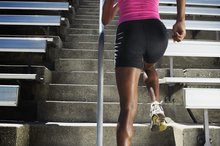What Are the Causes of Sacroiliac Subluxation?
Subluxation -- a less than full dislocation of a joint -- occurs when movement of a joint goes beyond its maximum range causing the bones to move out of alignment. Subluxations commonly occur in the sacroiliac (SI) joint, which is formed by the bottom of your spine and your pelvis. Causes of SI subluxation include trauma, poor posture, pregnancy and arthritis.
Trauma
SI subluxation is usually due to trauma. Unexpected jarring-type accidents, such as slips and falls or tripping, are the most common traumas leading to SI subluxation. Car accidents can also cause SI subluxations. Sports injuries, depending on the nature of the impact, can cause subluxations. A subluxated SI joint can affect surrounding blood flow, nerve function and muscle tension. SI joints can become completely dislocated with extreme trauma, but subluxation is much more common. Most SI subluxations cannot be detected with X-rays, however medical examination can reveal an unleveled pelvis.
- SI subluxation is usually due to trauma.
- SI joints can become completely dislocated with extreme trauma, but subluxation is much more common.
Poor Posture
Torn Tendons & Ligaments From Hyperextension
Learn More
Poor posture, which causes micro-trauma over longer periods of time, is the second most common cause of SI subluxation. Sitting in a car or at a desk for hours at a time creates too much forward bending, straining the ligaments that hold your SI joints together. Sleeping facedown, often creates too much backward bending, which causes compression in the SI joint. Leg-crossing while sitting or laying faceup can also strain ligaments and misalign your SI joints.
- Poor posture, which causes micro-trauma over longer periods of time, is the second most common cause of SI subluxation.
- Sleeping facedown, often creates too much backward bending, which causes compression in the SI joint.
Pregnancy
Another common cause of sacroiliac subluxation is pregnancy. Hormones released in a pregnant woman's body allow ligaments to loosen, which prepares the pelvis for childbirth. Relaxation of the SI ligaments allows for too much movement in the joints and can lead to increased stresses and abnormal wear in these joints. In addition, the increased weight and altered walking pattern associated with pregnancy also places stress on the SI joints.
- Another common cause of sacroiliac subluxation is pregnancy.
- In addition, the increased weight and altered walking pattern associated with pregnancy also places stress on the SI joints.
Arthritis
Complications After an Ankle Sprain
Learn More
Both osteoarthritis -- the wear and tear type -- and inflammatory types of arthritis can cause SI joint problems. SI subluxations created from mild to moderate arthritis can create popping or clicking sounds, although severe arthritis often leads to complete SI fusion.
Related Articles
References
- "Chiropractic Management of Spine Related Disorders"; Meridel I. Gatterman, D.C.; 2001
- "Special Tests for Orthopedic Examination, Third Edition"; Jeff G. Konin, Ph.D., A.T.C., P.T. et al.; 2006
- Wheeless' Online Textbook of Orthopaedics: Sacroiliac Joint
- American Academy of Orthopaedic Surgeons. Patellar dislocation and instability in children (unstable kneecap).
- American Academy of Orthopaedic Surgeons. Nursemaid’s elbow. Updated January 2019.
- Nabian MH, Zadegan SA, Zanjani LO, Mehrpour SR. Epidemiology of joint dislocations and ligamentous/tendinous injuries among 2,700 patients: Five-year trend of a tertiary center in Iran. Arch Bone Jt Surg. 2017;5(6):426-34.
- Skelley NW, Mccormick JJ, Smith MV. In-game management of common joint dislocations. Sports Health. 2014;6(3):246-55. doi:10.1177/1941738113499721
- Munakomi S, Das JM. Cervical subluxation. In: StatPearls. Updated July 4, 2020.
- Hart J. Analysis and adjustment of vertebral subluxation as a separate and distinct identity for the chiropractic profession: A commentary. J Chiropr Humanit. 2016;23(1):46-52. doi:10.1016/j.echu.2016.09.002
- American Academy of Orthopaedic Surgeons. Chronic shoulder instability. Updated December 2013.
- Hasler CC, Studer D. Patella instability in children and adolescents. EFORT Open Rev. 2016;1(5):160-6. doi:10.1302/2058-5241.1.000018
- American Academy of Orthopaedic Surgeons. Patellar dislocation and instability in children (unstable kneecap).
- American Academy of Orthopaedic Surgeons. Elbow dislocation. Updated October 2017.
- American Academy of Orthopaedic Surgeons. Nursemaid’s elbow. Updated January 2019.
- Olson SA, Furman B, Guilak F. Joint injury and post-traumatic arthritis. HSS J. 2012;8(1):23-5. doi:10.1007/s11420-011-9247-7
- Forghani I. Updates in clinical and genetics aspects of hypermobile Ehlers Danlos syndrome. Balkan Med J. 2019;36(1):12-6. doi:10.4274/balkanmedj.2018.1113
- American College of Obstetricians and Gynecologists. Exercise during pregnancy. Updated July 2019.
- Beltran LS, Bencardino JT, Beltran J. Imaging of sports ligamentous injuries of the elbow. Semin Musculoskelet Radiol. 2013;17(5):455-65. doi:10.1055/s-0033-1360666
- Cleveland Clinic. Dislocation management and treatment. Updated July 8, 2017.
- Virtanen KJ, Savolainen V, Tulikoura I, et al. Surgical treatment of chronic acromioclavicular joint dislocation with autogenous tendon grafts. Springerplus. 2014;3:420. doi:10.1186/2193-1801-3-420
- Godin J, Sekiya JK. Systematic review of rehabilitation versus operative stabilization for the treatment of first-time anterior shoulder dislocations. Sports Health. 2010;2(2):156-65. doi:10.1177/1941738109359507
- Matthew AH, Davis DD, Fish MJ, Stitson D. Osteonecrosis (avascular necrosis). In: StatPearls. Updated September 1, 2020.
Writer Bio
Aironius French has been writing professionally since 1999, when he became a clinical chiropractic physician. His health-related articles have appeared in the newspapers "Calgary Sun," "Calgary Herald," "Ajo Corridor Times" and "Rocky Point Times" and in "Penasco" magazine. French holds a Bachelor of Science in physical anthropology and human development from the University of Calgary and a doctorate from the Canadian Memorial Chiropractic College.









